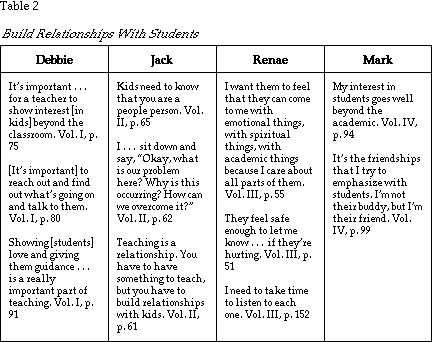
© Please note: Rhoda Summers owns the copyright for the dissertation below. You may download and print one copy for educational purposes only. These pages may not be duplicated, distributed, redistributed or republished in any manner without express permission from the author.
By this time his coat had worn . . . thin and threadbare from hugging. . . . He thought of those long sunlit hours in the garden--how happy they were--and a great sadness came over him. . . . Then a strange thing happened. . . .
"I am the nursery magic Fairy," [the visitor] said. "I take care of all the playthings that the children have loved. When they are old and worn out and the children don’t need them any more, then I come and turn them into Real."
"Wasn’t I Real before?" asked the little Rabbit.
"You were Real to the Boy," the Fairy said, "because he loved you. Now you shall be Real to every one."
Margery Williams, The Velveteen Rabbit
As the Rabbit was Real to the Boy who knew him, so the participants in my study are Real to me. Throughout chapters 3-6, I have chronicled their journeys toward becoming Real. The question concerning similarities in their stories remains, and looking for themes is the purpose of this chapter.
I first refer to the theoretical framework introduced in chapter 1. Then I present other themes which emerged outside of the existing framework. I also discuss selected literature and data collected through semi-structured interviews with principals used as key informants in selecting participants.
Van Hoose and Strahan (1988) write that "security, support, and success
may be the greatest needs faced in the middle grades. . . . [Young adolescents] are fragile, perhaps more fragile than at any other time in their lives" (p. 26). Middle school teachers have a wondrous opportunity as they relate to students in their classes to provide them with security and support. In many middle schools, special time is set aside in the schedule for students to meet in small groups with one advisor. Teachers, however, do not need to wait for designated advisory times to reach out to students and address their emotional needs.
Turning Points suggests that "close, trusting relationships with adults
. . . create a climate for personal growth" which middle schoolers need during this complex, often confusing time of life (Carnegie Council, 1989, p. 37). Similar sentiments are expressed in This We Believe when it calls for "middle level educators [who] are advocates for . . . young adolescents" (NMSA, 1995, p. 13) and who "provide ongoing assistance to help students successfully negotiate early adolescence" (NMSA, 1995, p. 31). Effective middle school teachers foster nurturing relationships with their students.
Relationships with middle schoolers should not be limited to the classroom. Dorman (1995) suggests that positive relationships with students are fostered by informal contact between students and teachers outside the classroom setting and by cooperative learning activities inside the classroom. In a case study of a teacher’s interactions with students, Mills (1997) found that Suzan, a sixth-grade science teacher, created a caring environment in her classroom by teaching students to work together, sharing stories of her personal life, encouraging students to talk about their concerns, attending their sports activities, and eating lunch with them.
The structure and programs of the middle schools where Debbie, Jack, Renae, and Mark teach vary. Both Debbie and Jack have students assigned to them for separate advisory periods while Renae and Mark have students assigned to their homeroom. In spite of terminology or students especially assigned to them, all four of these teachers spoke of the need and desire to relate to students on a personal level. They saw students as more than young people in need of knowledge; they recognized that students are whole persons and sought to build relationships with them. An important part of their role as teachers included helping students deal with issues outside of the written curriculum. Table 2 notes comments the four teachers participating in my study made about building relationships with students.
A student-centered curriculum is "based on the personal needs and interests of students as well as the social needs evolving from their everyday activities" (Hunt et al., 1998, p. 114). This type of curriculum often includes subject area and skills integration and service opportunities, and allows students to have input in the curriculum and make decisions about their learning experiences. For young adolescents, the curriculum must be "personally and socially relevant [and] interesting" (Hunt et al., 1998, p. 116).
Mark’s principal spoke specifically about the curriculum used by effective middle school teachers. He contends that teachers need to know their students well enough to recognize which students need to be pulled into
the learning activities and when a change in activities is needed. These teachers know and love their content areas in what he called a "creative sense" (Vol. V, p. 14). He explained this by saying that teachers need to draw

interesting aspects out of their content areas and connect these to middle schoolers in ways that arouse their curiosity. Once students are curious and involved with the content, teachers also need to look for ways to stretch students’ understanding and knowledge.
Teachers are encouraged to consult students in determining curriculum (NMSA, 1995). Chock-Eng (1995) utilized interviews, focus groups, observation, and a survey to explore seventh graders’ perceptions regarding school and classroom experiences which they believed improved and increased their learning. Participants in this study indicated that learning is enhanced when their own interests and questions are used in curriculum development. It is important to note that this suggestion comes from young adolescents and not from researchers or middle school educators.
Content studied in the classroom should be relevant to students’ lives (Carnegie Council, 1989). Students need to be involved in "activities that help them understand themselves and the world around them" (NMSA, 1995, p. 21). The academic content should help students "integrate their developing capabilities, interests, and relationships into a sense of who they are" (Dorman, 1995, p. 40). In an observational study, Hendershott (1997) identifies utilizing a curriculum relevant to students’ experiences and interests as a developmentally appropriate strategy of effective middle school teachers. These teachers connected students’ learning experiences to real-world situations which gave meaning to their learning.
The four teachers who participated in my study loved their content areas, but they used the subjects they taught as a means of teaching students other skills necessary to be successful in life. Woven throughout their curriculum were life skills and connections to the real world outside of the classroom. Students were encouraged to make decisions about their learning and investigate their interests. Table 3 displays quotes from the four participants concerning their views of curriculum.
Just as the curriculum for middle schoolers needs to be student-centered, so effective middle school teachers utilize teaching and learning strategies which are student-centered. Young adolescents’ developmental characteristics provide the foundation for choosing instructional strategies, and teachers need to utilize a vast repertoire of teaching and learning
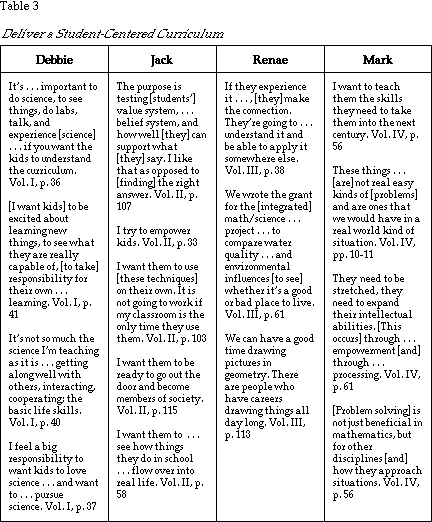
strategies to accommodate students’ needs (NMSA, 1995; Smith, 1992). Brunkhorst (1989) found that middle school science students’ learning is enhanced when their teachers use a variety of instructional strategies which complement young adolescent development.
In choosing teaching methods, a primary goal is to involve young adolescents in "active, engaged thinking" (Carnegie Council, 1989, p. 43). In order to realize this goal, students need to be actively involved in their learning, participate in hands-on activities, be allowed to make choices, discover new approaches to solving problems, work in small groups, and utilize learning centers (Carnegie Council, 1989; Chock-Eng, 1995; Dorman, 1995; Eccles, 1993; Hendershott, 1997; NMSA, 1995; Spector & Gibson, 1989). These approaches mean that teachers see their role in a different light; they are no longer dispensers of knowledge, but "facilitators through which young people construct knowledge" (Carnegie Council, 1989, p. 43).
In both the Carnegie Council’s Turning Points (1989) and NMSA’s This We Believe (1995), teachers are encouraged to use cooperative learning. When teachers utilize cooperative learning, students have the opportunity to work together for the success of all and develop positive relationships with peers. Cooperative learning promotes cooperation among students rather than the competition often fostered by tracking or homogeneous ability grouping (Carnegie Council, 1989; Dorman, 1995). A study of sixth and seventh graders involved in heterogeneous cooperative groups found that students’ regard for each other increased, they enjoyed receiving help from classmates, and they felt they learned more when working in groups (Farivar, 1992).
During the majority of my visits to Debbie’s, Jack’s, Renae’s, and Mark’s classrooms, students were busy working in pairs or small groups. Times of whole-class activities were marked by the teachers including all students as much as possible. Students were frequently moving around the room, learning activities were constantly changing, and I observed steady streams of interpersonal dialogue among students concerning the educational topics at hand. I saw students busily engaged in learning, not operating as passive observers. Table 4 is a compilation of the four participants’ comments about their instructional beliefs and practices.
Teaching middle schoolers is challenging and requires individuals who find young adolescents enjoyable and who are dedicated to teaching them (Dorman, 1995). According to Moss (1969), one of the problems with the original junior high school movement was that many teachers saw their teaching assignment as temporary, which resulted in a lack of deep commitment to teaching this age group. In 1974, Baldwin discussed the need for specially trained teachers if the middle school movement was to be successful. He envisioned this as an ongoing process, allowing teachers to develop a commitment to meeting the needs of the middle schoolers in their classrooms. Baldwin’s perspective is reiterated by John Lounsbury, a respected leader in the middle school movement. He states that success of the middle school movement is "as dependent upon teachers’ attitudes and approaches as upon their technical skills and knowledge" (Lounsbury, 1996, p. 3).
This We Believe (NMSA, 1995) cites one of the characteristics of developmentally responsive middle schools as educators committed to young
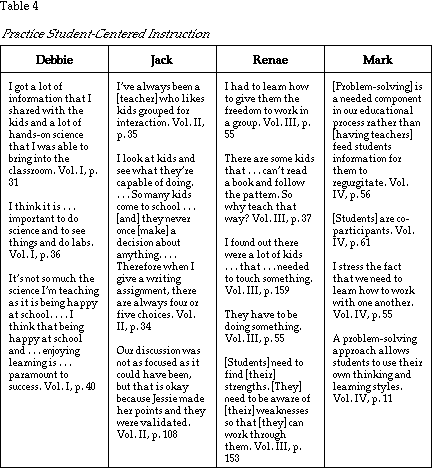
adolescents. A survey distributed to members of the NMSA concerning characteristics of middle school teachers indicates that the most effective middle school teachers are committed to working with young adolescents (Steer, 1984). A study utilizing long-term classroom observations, interviews, and informal interactions was conducted by Mills (1997) and a classroom teacher to investigate effective teachers of young adolescents. Mills discovered that teaching the way this teacher taught requires "incredible resources of time, energy, and materials" and "great investment of personal time" (p. 38). She concludes that this great personal commitment implies that middle school teachers enjoy and value teaching at this level.
Not only is commitment to middle schoolers a crucial ingredient, but genuine enthusiasm and a desire to teach these students are also needed. The Turning Points (Carnegie Council, 1989) report laments that many middle school teachers dislike their work or question their ability to adequately teach these students. It then states that the success of middle school education is dependent on teachers who not only understand, but also "find the middle grade school a rewarding place to work" (p. 58). This We Believe calls for educators who make a "conscious choice to work with young adolescents" and enjoy being with them (NMSA, 1995, p. 13).
A longitudinal study, conducted collaboratively by researchers and classroom teachers, sought to determine the characteristics of exemplary middle school teachers. Students were given three evaluation instruments, and their science teachers completed two questionnaires during 2 consecutive years. Results indicate that students’ knowledge of science improved when their teachers were enthusiastic about working with middle schoolers (Brunkhorst, 1989). An enthusiastic attitude prompts teachers to design appropriate learning experiences for middle schoolers.
The middle school years are a time of tremendous growth and change in young adolescents’ lives physically, emotionally, socially, intellectually, and morally. An understanding and knowledge of these changes and their implications for teaching and learning are crucial for effectively teaching these students. It is also important to remember that while developmental changes are often discussed as separate categories, young adolescents are whole persons and the physical, emotional, social, intellectual, and moral aspects of their being impact each other. Maturation in one category does not necessarily indicate maturation in the other categories (Carnegie Council, 1989); they are "inexorably intertwined" (NMSA, 1995, p. 6).
Growth and change do not occur in a vacuum, but the home, school, and community environments in which young adolescents find themselves also impact their development (Dorman, 1995). Young adolescents’ teachers can play a crucial role in helping them understand these changes, deal with their emotional and social implications, and make sense of this bewildering period in their lives (Carnegie Council, 1989; Merenbloom, 1991; Mueller, 1994; NMSA, 1995; Van Hoose & Strahan, 1988).
In the semi-structured interviews I conducted during the first phase of my data collection, the principals made several comments which indicate that effective middle school teachers thoroughly understand their students. In most instances they linked this understanding of middle schoolers with an ability to also relate to the students effectively. They believe teachers need theoretical knowledge of their students, but then they also need to be able to utilize this in what Elbaz (1983) calls teachers’ practical knowledge. This allows teachers to draw from theory and put it into practice.
According to the principals I interviewed, effective middle school teachers genuinely want to teach middle schoolers. These teachers are concerned about and like being with their students. This desire to be with middle schoolers also includes the ability to work with them. Teachers’ commitment to students extends outside the school setting into students’ extracurricular activities. The entire sphere of students’ lives becomes the concern of effective middle school teachers.
Debbie, Jack, Renae, and Mark as veteran middle school teachers understand their students well and thoroughly enjoy being with them. They are committed to middle schoolers and have chosen to teach at this level because they find it rewarding and challenging. Table 5 records some of their comments concerning their students and decision to teach middle schoolers.
As their children grow older, many parents find themselves becoming less involved in their education. This is unfortunate since parental involvement is beneficial for students’ achievement and positive attitudes toward school (Carnegie Council, 1989; NMSA, 1995). Middle school represents a new stage in their children’s lives, and parents may find the schools’ structure unfamiliar as well as feel bewildered by the changes their children experience as young adolescents. Effective middle school teachers keep parents informed of students’ progress, encourage parental involvement in the classroom, and establish lines of communication with parents.
The larger community contains a wealth of services and resources
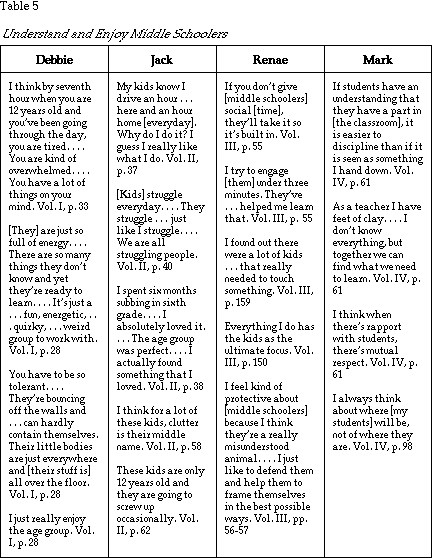
which middle school teachers can utilize in enriching the educational experience of their students. Middle schoolers benefit from volunteering in the community at organizations such as soup kitchens, senior citizen centers, child care centers, and parks (Carnegie Council, 1989). Establishing partnerships with community businesses and social service organizations allow middle schoolers to broaden their educational experiences to include the real world while also giving of themselves to these organizations (NMSA, 1995).
Six of the eight principals involved in my study mentioned that effective middle school teachers communicate well with the schools’ stakeholders. Though both Turning Points (Carnegie Council, 1989) and This We Believe (NMSA, 1995) mention that middle schools need to work at building strong relationships with parents and communities, I was surprised by the strong emphasis principals placed on this characteristic. They used phrases such as "liked" (Vol. V, p. 35), "well-respected" (Vol. V, p. 29), and have "good rapport" (Vol. V, p. 25) when describing teachers’ relationships with stakeholders.
As I observed and listened to the four participants in my study, I noticed them repeatedly maintaining communication with students’ parents and involvement in the communities. When I attempted to create a word table, however, I was unable to find many quotes regarding this theme. Had I not set aside the theoretical framework, I would have asked specific questions regarding parental and community involvement. My conclusions in this section are based strictly on observations and informal conversations instead of direct quotes from the participants.
In both Debbie’s and Renae’s classrooms, parents were frequent visitors, often unannounced. During my after-school visits with these two teachers, it was not unusual to be interrupted by a parent. While I seldom saw parents during my visits with Jack and Mark, both of them regularly spoke of conversations they had with students’ parents. Debbie and Mark spoke of personal relationships they have developed with some of their students’ parents. A number of Renae’s students attend the church which sponsors her school. This places her in frequent contact with students’ families in a social setting. Jack lives an hour’s drive from his school community which reduces the amount of social contact he has with students’ families.
Debbie, Jack, Renae, and Mark also involved their students in the community. Debbie regularly turned to butcher shops for donated specimens to use during dissection activities, and the entire sixth grade spent time with different businesses and organizations in the community, volunteering their time and learning about working there. A local Rotary Club sponsors an essay contest which Jack has his students enter each year. Renae works with the Society of Professional Engineers’ Math Counts program which some of her students enter yearly and regularly involves her students in service opportunities in the community. A yearly fund raiser for Renae’s school allows businesses to donate goods or services to benefit the school. Mark’s students had an opportunity to give of themselves to the world community by collecting supplies to make refugee kits for persons displaced by a conflict in Eastern Europe.
This We Believe describes a positive school climate which is applicable to any given classroom:
The climate . . . is safe, inviting, and caring; it promotes a sense of community and encourages learning. . . . Relationships are paramount, and all individuals are treated with dignity and respect. Students and adults recognize and accept one another’s differences; curiosity, creativity, and diversity are celebrated. Issues of gender and equity are addressed with sensitivity and fairness. The climate encourages positive risk-taking, initiative, and the building of substantive relationships. (NMSA, 1995, pp. 18-19)
A classroom with a positive climate is one where students feel accepted and where they want to be. Debbie, Jack, Renae, and Mark all created this type of classroom for their students. Table 6 reflects some of their ideas about their students and classroom.
During my interviews with principals, they addressed the classroom atmosphere created by effective middle school teachers. To my surprise, the most frequently mentioned aspect related to the discipline of students. The principals indicated that effective teachers establish clear, but reasonable and appropriate expectations for middle schoolers and are consistent in holding students accountable for meeting these expectations. It was also important to these principals that middle school teachers have the ability to relate to middle schoolers, establish rapport with them, and are serious about academics and genuinely care about students. One principal indicated that an ability to relate to middle schoolers is more important than teachers’ academic training. One observation made by a principal summarizes the atmosphere established by effective middle school teachers: An "environment that allows students to succeed" (Vol. V, p. 32). That is truly a positive classroom climate.
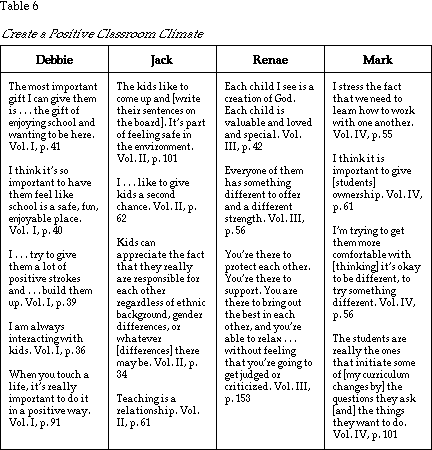
Though I was convinced prior to conducting the cross-case analysis for my research study that the four participating teachers were indeed effective middle school teachers, being able to use their own words and visually seeing how their comments and practices coincide with the ideas found in Turning Points and This We Believe was reassuring. Even though the four teachers often used different words concerning their beliefs, have different personalities, and appear unique on the surface, they hold consistent ideas about middle schoolers and how they should be taught.
Not only do I see my study supporting ideas presented in Turning Points and This We Believe, but I discovered other themes as I immersed myself in the data I had collected. These three themes, receptivity to growth, treasured relationships, and living intertwined professional and personal lives, reflect the participants’ views toward life. Though I am choosing to break them down into three characteristics, they are interwoven and impact each other.
In an article describing teachers who will be successful in the 21st century, Malone and Tulbert (1996) discuss "centered teachers" (p. 46). Among the qualities of centered teachers is the ability to change as students, schools, and the teaching profession change. "They participate in continuous self-improvement, are willing to break out of the comfort zone in order to make needed changes" (Malone & Tulbert, 1996, p. 46). Centered teachers’ commitment to life-long learning allows them to renew themselves, which in turn allows them to perform more effectively in both professional and personal arenas.
Similar thoughts are expressed by Senge (1990) when he uses the phrase personal mastery to describe a characteristic achieved through "the discipline of personal growth and learning" which includes every area of life, both personal and professional (p. 141). Senge (1990) goes on to describe individuals with high personal mastery: "They feel connected to others and to life itself. . . . [They] live in a continual learning mode [and] never ‘arrive.’. . . Personal mastery is not something you possess. It is a process. It is a lifelong discipline" (p. 142). These people are aware of areas in which growth is needed.
The concepts of centered teachers and personal mastery were evident in all four of the teachers who participated in my study. Instead of using either of these two phrases, I prefer calling this characteristic receptivity to growth.
I see both similarities and differences as I look at Table 7, which records participants’ comments about learning and change that have occurred in the course of their careers. Debbie and Renae indicate that they learned how to teach middle schoolers effectively from their students; Debbie and Jack talk about once having been curriculum- rather than student-centered and Mark’s story of change centers around a workshop he attended and the various committee appointments he held while teaching in Vermont.
All four participants spoke of the importance of relationships as part of their growth process. Debbie spoke of the "fellow mentoring type of teachers
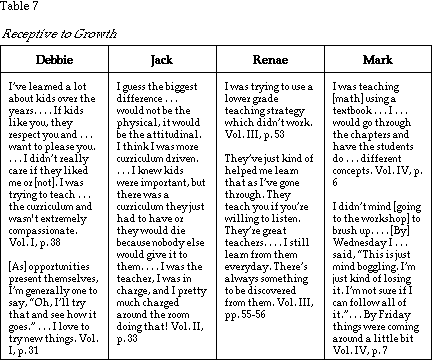
. . . [she] could go and talk to and know that [she] could say the truth" (Vol. I, p. 84). These teachers were ones whose advice Debbie valued and trusted.
Jack’s networking came from both inside and outside of his district. An early principal and a fellow teacher taught him to be more caring about his students and to view them through a gray lens. Jack also associated with educators at the state and national levels and these "professional opportunities outside the district allowed [him] to come back and do [his] job better" (Vol. II, p. 38).
Renae had been out of the K-12 classroom for a number of years when she began teaching middle school. She "needed a crash course" on manipulatives and decided that she was "going to figure it out" (Vol. III, p. 36). One of the things she did while trying to change her approach to teaching was contact the ISD in her county and take classes. This allowed her to network and learn from others. The ISD continues to support Renae’s efforts in the classroom, and she has in turn been sharing her expertise with others.
During the week Mark was involved in the workshop which totally changed his approach to teaching math, he also began establishing relationships with other educators. This networking was "crucial for [him] to maintain . . . a very different way of teaching" (Vol. IV, p. 7). Mark not only found the support necessary, but this group of teachers was collaborating in finding open-ended tasks to assign their students. They "were piggy backing off of each other" which made it easier for everyone to implement a problem-solving approach in their math classes (Vol. IV, p. 8). These four teachers’ stories underscore the value of support from peers when changing one’s approach to teaching.
Gardner (1990), a leader in business and political realms, speaks about the need for those in leadership to have "a circle of associates who are . . . supportive" (p. 135). Teachers, as leaders in the classroom, also need supportive relationships which help them combat the stresses and emotional drain of their tasks.
Using open-ended questionnaires, Pajak and Blase (1989) collected data from 200 teachers concerning the impact of their personal lives on their profession. They discovered that relationships outside of school are an important source of support in fulfilling professional duties. When teachers spend time with family and friends, "they are more likely to return to their classrooms . . . mentally and emotionally refreshed" (Pajak & Blase, 1989, p. 307). Malone and Tulbert (1996) also emphasize that an aspect of self-renewal for teachers is developing human relationships which provide a support network and allow teachers to balance their professional and personal lives.
As I considered the lives of the four participants in my study, I observed that they all live rich lives. Part of this richness stems from the joy, satisfaction, and fulfillment they find in their careers as educators, but that constitutes only a part of their lives. Gradually I came to realize that their lives are filled with, as Jack said, "things that make richer fabric rather than more fabric" (Vol. II, p. 135). Relationships with family and friends have created a rich tapestry in these four teachers’ lives which spills over into their classrooms. This rich tapestry allows these teachers to draw from their emotional wells when relating to students without depleting the supply because their wells are regularly replenished by other meaningful relationships in their lives. Table 8 displays comments made by the four participants concerning significant relationships in their lives.
Teaching does not occur within a vacuum, but life experiences shape who teachers are currently as well as impact their future experiences (Beattie, 1997). As I listened to the four participants in my study tell their stories and talk about their lives, I was constantly amazed at how they wove together their professional and personal lives. Each teacher specifically associated events or relationships in their personal lives with their beliefs and practices
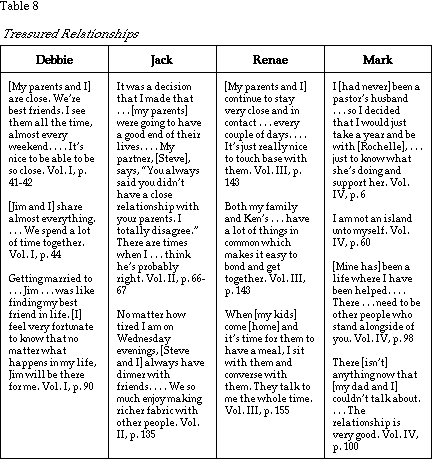
as a teacher. Table 9 records comments made by the four teachers.
In discussing teacher development, Goodson (1992) suggests seven
reasons for looking at the entirety of teachers’ lives: (1) Teachers consistently talk about their own lives in the process of explaining their practices and policies; (2) life experiences and background shape individuals, and when teachers invest themselves in teaching, their past experiences and background impact their practices; (3) teachers’ lifestyle in and out of school impact their views of teaching and their practices; (4) teachers’ life cycles and where they are in the cycle inform the decisions they make regarding their practices; (5) teachers’ career stages impact decisions they make about teaching; (6) teachers are molded by critical incidents in their lives; and (7) teachers’ lives intersect with their period in history and society. It would have been impossible to focus only on what I saw in the classrooms of the four participants in my study or to listen only to their comments about their educational beliefs. These teachers naturally drew from their lives outside of the classroom to explain reasons for their practices in the classroom.
As I completed chapters 3-6, I asked each of the four teachers to read his or her chapter, using a brief questionnaire to provide me with feedback concerning what I had written. We then had a semi-structured interview to discuss their thoughts. During the interviews I had with Mark and Jack, they both expressed surprise at how interwoven their professional and personal lives are. Seeing their written stories allowed them to conclude that their professional lives are intricately connected to their personal lives and that each informs the other.
Hansen (1995) spent more than 2 years with four middle and high
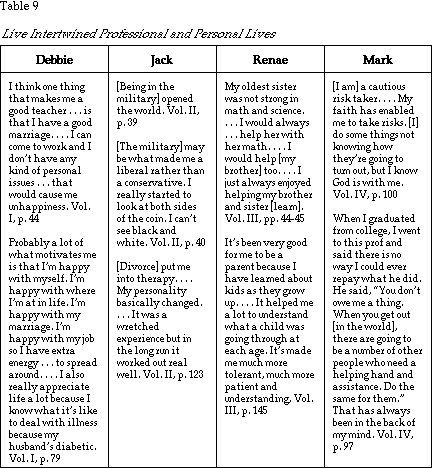
school teachers observing classes, and participating in formal and informal meetings and one-on-one conversations while trying to understand teachers’ beliefs about teaching and conceptions of themselves as teachers. He concludes that "person and practice are symbiotic" (p. 126). Aspects of each of these four teachers’ childhood experiences in schools remain with them and continue to impact their lives. In relating what has shaped these teachers, Hansen says that the "teachers have been influenced by their upbringing, by their education, and by their present working conditions" (p. 129). Individuals and groups of people which influence teachers include their families, students, administrators, and colleagues.
What Hansen discovered in the lives of the teachers he followed, I also discovered in Debbie, Jack, Renae, and Mark. Without hesitation, my participants identified childhood experiences in and out of school which have shaped and continue to influence who they are. They all spoke of the impact of their families in molding their current thoughts and beliefs, and all four of them discussed colleagues during their teaching careers who have left and indelible mark on their lives. As Schmidt (1997) notes, the relationship between teachers’ personal and professional lives and environments is "reciprocal and transactional" (p. 2).
Connelly and Clandinin (1995b) use the metaphor of a landscape in describing teachers’ professional lives. They believe that the professional landscape is in "intimate interaction with what one might call landscapes of the personal, outside the professional setting" (p. 27). Teachers’ professional landscapes take on a unique, particular shape as they draw from their own
individual biographies, on the particular histories of the professional landscape in which they find themselves, on how they are positioned on the landscape, and on the form of everyday school life on the landscape. Conversely, teachers’ professional life on the landscape influences their personal life off the landscape. (Connelly & Clandinin, 1995b, p. 27)
While using a landscape as a metaphor for teachers’ lives strikes a cord in my own mind and heart, I prefer the metaphor of a house. To me a house depicts an object that is a complete unit with distinct outside boundaries. Others are free to pass by a house, to make assumptions about what occurs inside the house, to speculate concerning its decorations; however, one needs to enter and explore its rooms and furnishings to appreciate its real value. Inside the houses built by teachers’ lives are separate rooms designating their personal and professional lives, but one finds easy access between the rooms. From the entryway, one can view bits and pieces of the other rooms. A general theme is prevalent in the decor of the entire house and the treasures in one room lead to and spill out into other rooms of the house. Though the appearance of individual teachers’ houses varies and some appear more welcoming initially, once one enters the houses created by effective middle school teachers’ lives, one finds safety, love, and acceptance.
Summary of Themes
These aspects of the four participants’ lives remind me that they are whole persons, just like the young adolescents they teach. They live lives that allow them to be whole and complete. What affects them either mentally, emotionally, morally, or physically also touches the other areas. When they grow mentally, they are also touched emotionally and morally. When they feel renewed emotionally, they are also able to be more creative and give of themselves to their students (Covey, 1989).
The participants in my study fit well within the profile of effective middle school teachers as found in the existing middle school literature. Because of the last three themes I observed and found reflected in the literature of effective leaders, this study also contributes a new lens through which to view and consider effective middle school teachers. These four middle school teachers are not only effective middle school teachers, but they are also effective in their personal lives.
Debbie, Jack, Renae, and Mark are Real because they love and are loved. They recognize that becoming Real is sometimes a painful process, yet they open their arms to embrace the lessons of life as they continue the journey toward being Real. They learn from the others they encounter and do not rest on their laurels and accomplishments. As the participants allow their lives to touch those around them, others are invited to also become Real by embracing the process. The journey toward becoming Real leads to more joy, adventure, and fulfillment than one could ever imagine.